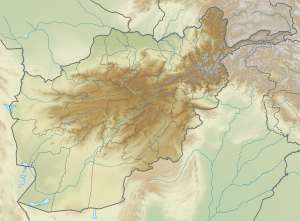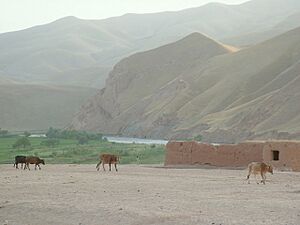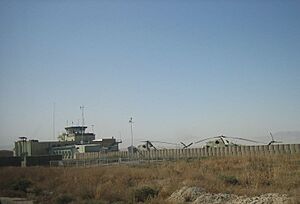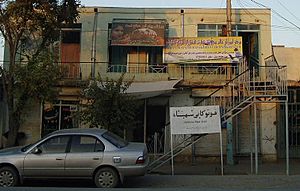Kunduz facts for kids
Quick facts for kids
Kunduz
Persian: قندوز
|
|
|---|---|
 |
|
| Country | |
| Province | Kunduz Province |
| District | Kunduz District |
| First mention | 329 BCE |
| Area | |
| • Total | 11,206 ha (27,691 acre) |
| • Land | 112 km2 (43 sq mi) |
| Elevation | 351 m (1,152 ft) |
| Population
(2014–2015)
|
|
| • Total | 268,893 |
| Population total is estimated | |
| Time zone | UTC+4:30 (Afghanistan Time) |
| Postal code |
35XX
|
| Main language | |
| Climate | BSk |
Kunduz is a major city in northern Afghanistan. It is the capital of Kunduz Province. About 268,893 people lived there in 2015. This makes it one of Afghanistan's largest cities. It is also the biggest city in northeastern Afghanistan.
Kunduz is located in a historic area called Tokharistan. It sits near where the Kunduz River and Khanabad River meet. Important highways connect Kunduz to other cities. These include Kabul to the south and Mazar-i-Sharif to the west. It also links to Badakhshan in the east. You can also travel north to Dushanbe in Tajikistan from Kunduz. This is done through a special border crossing called Sherkhan Bandar. Kunduz is well-known in Afghanistan for growing lots of watermelons.
In 2015, most of the city's land was used for farming. This was about 65.8% of the total area. Homes made up almost half of the developed land. There were nearly 30,000 houses. Some land was also used for public buildings and the airport.
Contents
What's in a Name?
The city's name, Kunduz, can be spelled in many ways. Some common spellings are Kundûz, Qonduz, or Kondoz. The name comes from an old Persian phrase. It means "old fort."
A Look at Kunduz's Past
Kunduz has a very long history. It was once an ancient city called Drapsaka. In the 3rd century AD, it was a big center for Buddhist learning. The city was very successful during that time.
Long ago, the city was known as Aornos. Later, it was called Walwalij. The name Kuhandiz started to be used during the Timurid period.
Early History and Growth
In the 18th and 19th centuries, Kunduz was the capital of an Uzbek kingdom. This kingdom was called the Kunduz Khanate. It grew very large under a ruler named Mohammad Murad Beg. His rule lasted from 1815 to 1842. The kingdom stretched from Balkh to the Pamir Mountains. After Murad Beg was defeated, his kingdom became weaker. Eventually, Afghanistan took control of it in 1859.
In the early 1900s, many Tajiks and Uzbeks moved to northern Afghanistan. They were fleeing from the Russian Red Army.
Kunduz in the 20th Century
In the early 20th century, Kunduz became one of Afghanistan's richest provinces. This happened under the leadership of Sher Khan Nashir. He started the Spinzar Cotton Company. This company still exists today. At its busiest, it employed 5,000 people. Kunduz is a very important farming area. It grows wheat, rice, and millet. Because of its rich agriculture, it was called "the hive of the country."
Kunduz in Recent Times
Kunduz is a key city for the northeastern provinces. In 1997, it came under the control of the Taliban. It was the last major city they held. In November 2001, forces supported by the US took it back.
In 2015, there was fighting in the city. This caused many people to leave their homes. In August 2021, the Taliban took control of Kunduz again. This was part of a larger military action across Afghanistan.
Where is Kunduz?
Kunduz is in a very important location. It is on the main highway that goes north and south. This highway connects Kabul to Tajikistan. It is also on the east-west road. This road links Mazar-i-Sharif to Taloqan and Fayzabad.
Kunduz Weather
Kunduz has a cold semi-arid climate. This means it has hot summers and cool winters. It doesn't rain much, except from January to April. Summers are almost always dry.
| Climate data for Kunduz | |||||||||||||
|---|---|---|---|---|---|---|---|---|---|---|---|---|---|
| Month | Jan | Feb | Mar | Apr | May | Jun | Jul | Aug | Sep | Oct | Nov | Dec | Year |
| Record high °C (°F) | 21.2 (70.2) |
25.0 (77.0) |
32.8 (91.0) |
38.9 (102.0) |
42.2 (108.0) |
46.2 (115.2) |
45.3 (113.5) |
44.2 (111.6) |
39.2 (102.6) |
39.4 (102.9) |
28.4 (83.1) |
21.6 (70.9) |
46.2 (115.2) |
| Mean daily maximum °C (°F) | 6.3 (43.3) |
9.5 (49.1) |
15.8 (60.4) |
23.0 (73.4) |
29.8 (85.6) |
37.3 (99.1) |
39.0 (102.2) |
36.9 (98.4) |
31.8 (89.2) |
24.5 (76.1) |
16.0 (60.8) |
9.7 (49.5) |
23.3 (73.9) |
| Daily mean °C (°F) | 1.6 (34.9) |
4.4 (39.9) |
10.4 (50.7) |
17.2 (63.0) |
22.9 (73.2) |
29.3 (84.7) |
31.3 (88.3) |
29.2 (84.6) |
23.9 (75.0) |
16.9 (62.4) |
9.5 (49.1) |
4.4 (39.9) |
16.8 (62.1) |
| Mean daily minimum °C (°F) | −2.4 (27.7) |
0.0 (32.0) |
5.7 (42.3) |
11.6 (52.9) |
15.7 (60.3) |
20.9 (69.6) |
23.3 (73.9) |
21.5 (70.7) |
16.3 (61.3) |
10.6 (51.1) |
4.1 (39.4) |
0.0 (32.0) |
10.6 (51.1) |
| Record low °C (°F) | −22.7 (−8.9) |
−23.1 (−9.6) |
−11.8 (10.8) |
−2.1 (28.2) |
4.2 (39.6) |
12.5 (54.5) |
15.7 (60.3) |
12.6 (54.7) |
3.5 (38.3) |
−2.0 (28.4) |
−9.8 (14.4) |
−20 (−4) |
−23.1 (−9.6) |
| Average precipitation mm (inches) | 44.0 (1.73) |
56.5 (2.22) |
76.7 (3.02) |
54.4 (2.14) |
29.8 (1.17) |
0.1 (0.00) |
1.3 (0.05) |
0.3 (0.01) |
0.1 (0.00) |
7.3 (0.29) |
23.7 (0.93) |
28.4 (1.12) |
322.6 (12.68) |
| Average rainy days | 5 | 6 | 11 | 10 | 9 | 1 | 1 | 0 | 0 | 3 | 5 | 6 | 57 |
| Average snowy days | 5 | 4 | 2 | 0 | 0 | 0 | 0 | 0 | 0 | 0 | 1 | 2 | 14 |
| Average relative humidity (%) | 80 | 75 | 75 | 71 | 54 | 31 | 28 | 29 | 32 | 44 | 63 | 76 | 55 |
| Mean monthly sunshine hours | 114.4 | 114.6 | 158.9 | 201.0 | 276.5 | 332.1 | 340.2 | 315.5 | 289.7 | 221.8 | 169.3 | 118.3 | 2,652.3 |
| Source: NOAA (1958–1983) | |||||||||||||
Who Lives in Kunduz?
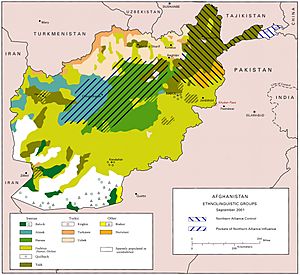
In 2015, about 268,893 people lived in Kunduz. The largest group of people are Pashtuns. Other groups include Uzbeks, Tajiks, and Arabs. There are also a few other smaller groups. Kunduz Province is very diverse. It has many different ethnic groups living together.
Some people in Kunduz identify as Arabs. They speak Persian and Pashto, which are Afghanistan's main languages. They feel a strong connection to their Arab heritage. This connection comes from Arab tribes who moved to this area long ago. This happened after the Islamic conquests in the 7th and 8th centuries.
City Management
Kunduz city is divided into 8 areas called 'Nahias'. The total land area of the city is about 11,206 hectares.
Sports in Kunduz
Kunduz has professional sports teams.
| Club | League | Sport | Venue | Established |
|---|---|---|---|---|
| Pamir Zalmi | Shpageeza Cricket League | Cricket | Kunduz Cricket Ground | 2021 |
| Mawjhai Amu F.C. | Afghan Premier League | Football | Kunduz Ground | 2012 |
The city has two main sports venues:
- Kunduz Cricket Ground
- Kunduz Ground
Famous People from Kunduz
Many notable people come from Kunduz.
- Sher Khan Nasher - A leader of the Kharoti Nasher tribe.
- Gholam Nabi Nasher Khan (1926–2010) - A member of parliament.
- Sayed Noorullah Murad - An Afghan politician, cabinet member, and military commander.
- Hamidullah Yousafzai - An Afghan football player. He played for the Afghanistan national football team.
- Javed Ahmadi (1992–) - A player for the Afghanistan national cricket team.
- Abdul Rauf Ibrahimi - A former Speaker of the Afghan National Parliament.
- Farhad Darya - A well-known Afghan singer.
Images for kids
See also
 In Spanish: Qundūz para niños
In Spanish: Qundūz para niños


